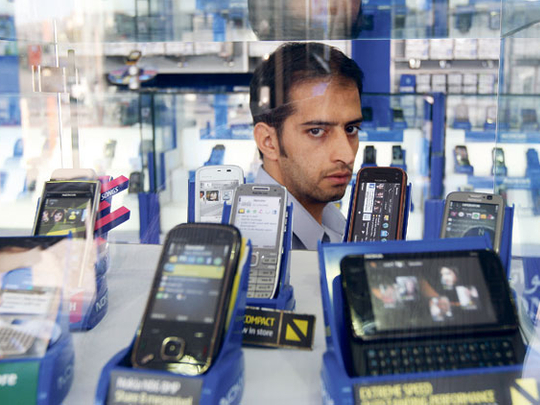
Dubai: The UAE's seemingly unstoppable mobile phone growth may finally be nearing its zenith, according to a new business report.
Business Monitor International (BMI) suggests that three years of runaway sales of mobile phones could stall in 2011 when market saturation matures.
Mobile phone penetration has skyrocketed from roughly 162 phone subscribers per 100 inhabitants in 2007 to 240 subscribers per 100 inhabitants this year, said BMI.
Next year, the prediction is that penetration will only climb to 241 subscribers per 100 inhabitants, the smallest increase in years.
"The UAE's mobile sector is close to saturation with the official penetration rate one of the highest in the world," says the latest BMI United Arab Emirates Telecommunications Report for the second quarter of 2010.
With a stabilised penetration rate, the number of mobile phone subscribers in the UAE next year should be about 11.9 million compared to 7.2 million subscribers in 2007, BMI said.
The downside to a levelling off, BMI suggested, is that high "penetration rates in all the UAE's telecoms sub-sectors offer few growth prospects."
In an interview from London, Rosalind Craven, BMI Senior Telecommunications Analyst, said UAE telecoms du and etisalat should be fully expecting a levelling off of penetration growth.
"We have to say this rate is unsustainable," said Craven. "It can't keep growing. People will not keep buying mobile devices. We think that in 2011 we will see a significant cooling in SIM growth."
Countries around the world such as those in Europe have seen mobile phone rates stabilise to a penetration rate on average of about 130-160 subscribers per 100 inhabitants, Craven said. In developed economies "they are all facing diminished growth on new subsidies."
Expanding mobile penetration, however, is only one aspect of the telecom industry, she said, with countries such as the UAE now eyeing next business steps to rake in ancillary business revenues.
"New growth will come in value-added services," Craven said. "Anything that isn't a basic core service or SMS."
One of those new money-making services for UAE providers is mobile TV broadcasting which can stream live feeds of popular programmes to handheld devices configured to enable owners to watch their favourite shows.
Additional revenue
The BMI report said, "Introduction of new multimedia smartphones and innovative services should stimulate demand for mobile internet services and should also generate further opportunities for content providers."
Additional revenue will stem from the Telecommunications Regulatory Authority (TRA) decision to move into mobile TV broadcasting. The TRA is "preparing to issue new mobile TV broadcast licenses," BMI said.
Report authors lauded the UAE telecommunications industry for solid business growth amid a global financial downturn, a time when many other telecoms around the globe struggled.
BMI said that the UAE's "10.672 million mobile customers at the end of 2009 is based on growth of over 12 per cent in 2009 as a whole. Although considerably lower than in 2008, this was still an impressive achievement given that the country saw its population shrink in 2009. We continue to anticipate growth in each subsequent forecast year. This is in spite of the fact that the market is increasingly saturated."
With the world possibly emerging from recession, BMI said that it "predicts that from 2010 the UAE will start growing again on the back of economic recovery.
"We expect this development to result in renewed demand for mobile services from a second wave of migrant workers."
Indeed, while mobile phone penetration is not likely to continue expanding at great numbers, new workers entering the UAE will help sustain one of the highest penetration rates in the world, the report said.
"The demographic characteristics of the UAE, together with the high proportion of prepaid users, means that the level of multiple SIM ownership is likely to continue being high," BMI stated.
3G expansion remains strong
According to BMI, the UAE loves its 3G phones. The report said, "The 3G forecast is based on an estimate of 1.52 million by the end of 2009 (equivalent to 14.2 per cent of the total mobile user base). Our forecast is based on the assumption that continued 3G growth will be driven by both price cuts and advances in the type of content and value-added services that are offered; growth will also be fuelled by the proliferation of a wider range of handsets. Based on our forecast for the mobile market as a whole, we envisage that 3G customers will account for around 20 per cent of the mobile market [by] the end of 2014."












